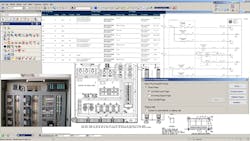Where does electrical CAD software stand with the digital twin?
Integration of mechanical CAD (MCAD) and electrical CAD (ECAD) tools holds the promises of collaboration and reusability. While some software suppliers sing of integration’s importance, others still stick to using the design program that fits the engineering discipline best. Electronic design automation especially highlights a variety of tasks that speed development and enable cooperation. Our expert panel focuses on where ECAD is making a difference.
ALSO READ: How does the investment in software training compare to the returns?
How is ECAD software helping machine builders to keep better control of their designs?
Where MCAD and Excel are still used to do the electrical design, a dedicated ECAD software with a worksheet style editor for mass data handling not only enhances the quality of the documentation, but also saves a lot of time creating and maintaining the diagrams.
Along those lines, there’s more and more pressure to integrate all manner of different devices and capabilities for which it’s hard for the traditional players to build OTS solutions fast enough. With the proliferation of sensors and unique ways to collect and manage data, build better user interfaces and better user experiences, it’s clear that the one with the most dynamic and flexible tools at its disposal will win the contract.
How does ECAD software help to bring together the electrical and mechanical design teams?
Berggren, Autodesk: How did we view these problems as independent for so long? Whether it’s software or circuits or mechanics, these are all just views into the same problem. More and more, they are being solved by fewer people. And if we accept that electronics are just a way for software to bridge the real world, it’s pretty obvious that we need this piece to connect the stack from conceptualization to implementation to feedback and analytics.
Combining these processes lays the foundations for a completely new way of thinking about problems and delivering the comprehensive set of tools necessary to develop the complete solution, end to end. ECAD brings the software and mechanics together in design, just as it does in the real world. This is just aligning our strategy with the world the way that it is and not fighting it.
Ott, Aucotec: Within the team that designs a system with mechanical, electrical, fluid and software components, each discipline should use the software that fits best to their needs. Using the software just because “we already have it” or “we’ve always used it” will not help to improve the processes. An interface between ECAD and MCAD systems then allows the team members to navigate directly from the electrical components in the ECAD system to its 3D representation in the MCAD system, and vice versa, and therefore helps team members to even better understand the full picture of a systems design. With access to the data via Web browser or even apps, engineering data becomes available to all team members. Thus improving communication and therefore helping to reduce misunderstandings.
Bozic, Bentley Systems: We have focused on enabling our users to digitally reference a 3D machine layout drawing into the corresponding electrical drawing. An electrical designer can then place and tag electrical devices such as motors and sensors on the 3D model. The 3D representation of these devices can be cross-referenced to the detailed schematic diagrams to ensure accuracy and consistency. Users can also create section views of the 3D model that include the electrical equipment to create detailed drawings. Mechanical designers can then see the electrical equipment and their tags in these section views. The same equipment tags can be managed in mechanical and electrical models.
Wilson, Mentor Graphics: Thermal design software is well integrated into the ECAD and MCAD workflows and can readily import neutral, and at times product-specific, mechanical and electrical designs. It is also possible to export component placement information from the thermal tool back into the ECAD workflow. This is useful early in the design process if placement of components and routing isn’t finalized.
How does ECAD enable mass customization and the digital twin?
Ott, Aucotec: The electrical design consists of much more than just the diagrams. The diagrams are only the simplified representation of a complex design. Moreover it is the detailed data about devices, terminals, pins, cables and wires and how everything is connected that makes the digital twin. Mass customization requires a software with a three-tier architecture and a database that is powerful enough to handle business-critical data in a multi-user environment and efficient tools that allow comfortable handling of large amounts of data, configuration and re-configuration of pre-specified modules with variants and options.
Bozic, Bentley Systems: Through comprehensive and integrated 2D and 3D design, our users build a fully digitalized machine model that includes all the drawings, schematics and metadata of the manufactured components from the design. The model then serves as an accurate reference for all project stakeholders.
Berggren, Autodesk: By itself, it doesn’t. Rather, to make this work we need to challenge the traditional design and manufacturing paradigm, with help also from customers, industry and a range of content partners.
What we’re focused on is really how we take common ECAD problems—which are really combined software, hardware and mechanics problems—and “discretize” them, making the framework for common solutions to be introduced into user designs. This requires an elaborate framework for how we collect and integrate content, how we create the taxonomy to make this all searchable and consumable and then how we manage metadata like pricing, performance and geometry.
How we deliver all of this in a seamless experience from software to ECAD to MCAD, through the manufacturing pipeline, and then back into the analytics and data framework after it’s deployed in the field is where our focus is these days.
As this framework takes shape, our expectation is that these elements take on standards of their own, both in terms of capability, connectivity/buses and physical layout. So, dropping these in should be super easy. That of course has to map through to manufacturing, where we’re aware of what components are loaded on a pick-and-place machine for example and can even optimize the downstream workflow to ensure an unparalleled path from design to fabrication to assembly to the consumer. This is where customization becomes possible—by reducing the design problems to the smallest useful definition which captures an experience and making it painless to implement.
With regard to the digital twin, we view this problem in much the same way, looking at simulation and modeling as a single, unified process that requires all of the elements to eventually converge. So, whether that’s cycle-accurate simulation of a PLC or an embedded processor to event-driven simulation of a mechanical system to the associated loads and stresses, this is one problem, and something we’re confident we can achieve. For sure it’s a hard problem, but, if we’re not solving hard problems, we’re not really creating value.
Wilson, Mentor Graphics: Computational fluid dynamics (CFD) software is often driven externally by either an optimization or design management interface. Many times there are multiple design constraints from various disciplines and controlling the software externally, in terms of building, solving and exporting results back into the controlling software, will both speed up the design process and also result in a better design.
What are ways ECAD helps with reusable designs and makes designs more efficient?
Ott, Aucotec: With ECAD and the centralized libraries and detailed access permissions for libraries such as symbols, drawing borders and template projects, the electrical design first becomes more standardized. This standardization is the first step to a truly reusable design and allows the user to reuse and mix designs from other engineers and their previous projects. With modularization and use of standardized and quality-checked modules, electrical design becomes even more efficient.
Bozic, Bentley Systems: We have enabled time savings for our users through a fully functional API and templates for drawing automation. Each can auto-generate a complete set of project drawings that include schematics, panel layouts and wiring diagrams (Figure 1). Users who are not looking for this degree of automation can still copy template drawings from other projects and reuse typical circuits or layouts as desired.
Figure 1: Intelligent electrical design software enables users to save time and reduce errors by consolidating schematics, 3D layouts and internal wiring and termination diagrams.
(Source: Bentley)
Wilson, Mentor Graphics: Thermal design software for electronics builds thermal models that contain all of the necessary information—dimension, material, heat dissipation, meshing controls and characteristic performance data—in a portable format. A part or subassembly can be exported to a library, colleague or customer with a click of a button. This allows for models to be built more quickly and more accurately since you can get models directly from a vendor. In some cases there is vendor-neutral data that can be used by most thermal design tools available on the market.
Berggren, Autodesk: We’ve already introduced a way to select and store subcircuits that maintain the symbolic (sch) and physical (pcb) data in a reusable form. This is the first step on the path toward something more comprehensive, but an important first step for sure.
Take, for example, a Wi-Fi circuit. As a radio-frequency (RF) engineer, I have a unique set of skills that qualify me to build wireless circuits, whether that’s Wi-Fi or Bluetooth-low-energy (BLE) or ZigBee or something altogether different. My ability to capture those solutions and socialize them across my company, or even a community, means my power-electronics engineers or my field-programmable-gate-array (FPGA) or embedded-system folks get the benefit of this experience. Likewise, I’m depending on them for a power supply that’s stable and a processor that’s well-isolated from the analog front end.
You should expect mechanical engineers to one day be able to build printed-circuit-board (PCB) hardware. Likewise, embedded software engineers or electrical engineers should have the ability to integrate complex mechanics and move up and down the stack and out to manufacture.
Mike Bacidore is the editor in chief for Control Design magazine. He is an award-winning columnist, earning a Gold Regional Award and a Silver National Award from the American Society of Business Publication Editors. Email him at [email protected].
About the Author
Mike Bacidore
Editor in Chief
Mike Bacidore is chief editor of Control Design and has been an integral part of the Endeavor Business Media editorial team since 2007. Previously, he was editorial director at Hughes Communications and a portfolio manager of the human resources and labor law areas at Wolters Kluwer. Bacidore holds a BA from the University of Illinois and an MBA from Lake Forest Graduate School of Management. He is an award-winning columnist, earning multiple regional and national awards from the American Society of Business Publication Editors. He may be reached at [email protected]

Leaders relevant to this article:







